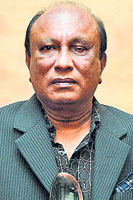Deshabandu Dr. Tissa Abeysekara – my schoolmate at Dharmapala Vidayala, Pannipitiya, in the early 1950s, and my lifelong friend for nearly six decades – has departed, leaving an indelible impression of awe and admiration in the minds of all Sri Lankans devoted to indigenous culture, literature and the arts.
I have happy memories of the times we spent together in school during those carefree, idyllic post-Independence days.
Tissa was three years junior to me in school. He came to prominence as a young and charismatic titan who spoke perfect English and made no bones about his revolutionary political leanings.
He loved his school and respected his teachers. As a senior student, he displayed exemplary leadership qualities.
The students of our generation enjoyed the best of both worlds. We had English as our medium of instruction, but we also gave equal importance to the study of the Sinhala language and literature.
Tissa was a voracious reader with a good memory. His mind was a vast storehouse of knowledge. In later life he would say that the formal education he received at Dharmapala was comprehensive and complete, and was more than adequate for the literary and creative work he would pursue in later life.
He participated in almost every extra-curricular activity the college offered. He was a good orator and debater, and represented Dharmapala at inter-school oratory competitions and debates, speaking in both English and Sinhala. He held several key positions in the school’s various societies, including the literary, film and drama societies. He proved his journalistic capabilities as editor of the college magazine. He was also a cadet, and was adjudged best sergeant at one of the annual cadet camps at Diyatalawa.
While still a student, Tissa reviewed Dr. Lester James Pieris’s groundbreaking film “Rekhawa”, which heralded a new era in Sinhala cinema. Lester recognised young Tissa’s brilliance and took him under his wing and groomed him to be a great film maker.
Tissa Abeysekara was unique in that he showed genius in two fields: creative writing and innovative film-making. He made his Sinhala silver screen debut in the early 1960s as a scriptwriter. Later he directed such box-office hits as “Karumakkarayo”, “Mahagedara”, “Nidhanaya” and “Viragaya”.
Tissa acknowledged in his writings his mother’s influence on his life and outlook by instilling in him traditional Sinhala village values and the Buddhist qualities of loving kindness and compassion.
He was supremely bilingual, communicating fluently in both Sinhala and English, which he described as his “surrogate mother tongue”.
His literary works include “Ipanella” (short stories) and “Pitagamkarayo” (a novel), “Ayale Giya Sithaka Satahan” (essays), “Rupa-Svarupa” (essay on film) and “Cinema Sithuvili” (on the art of film).
Tissa Abeyesekara started writing in English later in life. His English novel “Bringing Tony Home” won the coveted Gratiaen Prize in 1996. “Roots, Reflections and Reminiscences”, his last book in English, chronicles his lifelong search for his roots and identity in a historical and cultural context.
Tissa was a man of many parts. He was a film director,actor, film critic, and a writer. I believe his uniqueness stems from his genealogy, his social background, his rural upbringing and his liberal education.
It is possible that his creativity and intellectual strengths derived from his genetic diversity: his father came of weather-beaten, low-country stock, while his mother was a docile and deeply religious village lady with Kandyan roots.
Tissa’s personality was characterised by his multi-cultural, multi-social background: His father came from an Anglicised English-speaking upper-middle class family, while his mother came from a Buddhist, Sinhala-speaking lower-middle class family with roots in the village.
Tissa Abeysekara beautifully portrayed in his writing and on celluloid the unpolluted, verdant rural environment he grew up in. The Kelani Valley is rich in folk art, dance, drama and music, and all these enriched his mind and stimulated his creativity.
Tissa Abeysekara’s parents made a wise decision when they sent their son to Dharmapala Vidyalaya. The school gave him a liberal, bilingual and complete education and provided him access to both Eastern and Western cultures. Although he did not pursue higher studies, Tissa’s senior secondary education at Dharmapala equipped him more than adequately for his roles as writer and filmmaker.
May he attain Nibbana!
Deshamanya K. H. J.
Wijayadasa |

